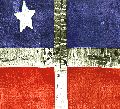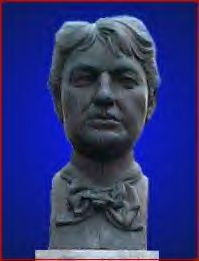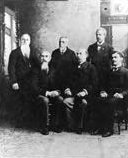|
Lares Uprising
''El Grito de Lares'' (''The Cry of Lares''), also referred to as the Lares uprising, the Lares revolt, the Lares rebellion, or the Lares revolution, was the first major revolt against Captaincy General of Puerto Rico, Spanish rule in Puerto Rico. The revolt was planned by Ramón Emeterio Betances and Segundo Ruiz Belvis. It began on September 23, 1868 in the town of Lares, Puerto Rico, Lares, for which it is named. It spread rapidly to various revolutionary cells throughout the island. Causes of revolt In the 1860s, the government of Spain was involved in several conflicts across Latin America. It became involved in Chincha Islands War, a war with Peru and Chile and had to address slave revolts in Cuba. At the time, Puerto Rico and Cuba also suffered a severe economic crisis because of increasing tariffs and taxes imposed by the Spanish central government on most import and export goods. The Spanish crown needed the funds badly to subsidize its troops in the Dominican Repub ... [...More Info...] [...Related Items...] OR: [Wikipedia] [Google] [Baidu] |
Lares, Puerto Rico
Lares (, ) is a mountain town and municipality of Puerto Rico's central-western area. Lares is located north of Maricao and Yauco; south of Camuy, east of San Sebastián and Las Marias; and west of Hatillo, Utuado and Adjuntas. Lares is spread over 10 barrios and Lares Pueblo (Downtown Lares). It is part of the Aguadilla-Isabela-San Sebastián Metropolitan Statistical Area. A city adorned with Spanish-era colonial-style churches and small downtown stores, Lares is located on a breezy area that is about 1.5 hours from San Juan by car. Lares was the site of the 1868 ''El Grito de Lares'' (literally, ''The Cry of Lares'', or Lares Revolt), an uprising brought on by pro-independence rebels who wanted Puerto Rico to gain its freedom from Spain. Even though it was soon extinguished it remains an iconic historical event in the history of the island. History Lares was founded on April 26, 1827, by Francisco de Sotomayor and Pedro Vélez Borrero, who named the town after Amador ... [...More Info...] [...Related Items...] OR: [Wikipedia] [Google] [Baidu] |
Carolina, Puerto Rico
Carolina (; ) is a city and municipality located on the northeast coast of Puerto Rico. It lies immediately east of the capital San Juan and Trujillo Alto; north of Gurabo and Juncos; and west of Canóvanas and Loíza. Carolina is spread over 12 barrios plus Carolina Pueblo (the downtown area and administrative center). It is part of the San Juan-Caguas-Guaynabo Metropolitan Statistical Area, and home to Puerto Rico's main airport, the Luis Muñoz Marín International Airport. History The town was founded by Spanish colonists in 1816 as Trujillo Bajo ("lower Trujillo"), along with its counterpart Trujillo Alto after Trujillo, Spain. In 1857 it was renamed to San Fernando de la Carolina, later shortened to ''Carolina'', after Charles II of Spain. The city is known as ''"Tierra de Gigantes"'' (Land of Giants), not only for well-known Carolina resident Don Felipe Birriel González (who was 7'11"), but also in honor of other people from Carolina, including poet Julia de Burg ... [...More Info...] [...Related Items...] OR: [Wikipedia] [Google] [Baidu] |
Flags Of Puerto Rico
The flag of Puerto Rico ( es, link=yes, Bandera de Puerto Rico) represents and symbolizes Puerto Rico and its people. The origins of the current flag of Puerto Rico, adopted by the Commonwealth of Puerto Rico in 1952, can be traced to 1868, when the first Puerto Rican flag, " The Revolutionary Flag of Lares", was conceived by Dr. Ramón Emeterio Betances and embroidered by Mariana "Brazos de Oro" Bracetti. This flag was used in the short-lived Puerto Rican revolt against Spanish rule in the island, known as "El Grito de Lares", establishing for the first time a Puerto Rican national consciousness under colonial rule."Puerto Rico - Cinco Siglos de Historia"; by: Francisco Sacrano; publisher: McGraw Hill Interamericana, SA, 1993; pag. 533 Juan de Mata Terreforte, an exiled veteran of "El Grito de Lares" and vice-president of the Puerto Rican Revolutionary Committee, in New York City, adopted with its members the flag of Lares as the flag of Puerto Rico, until 1895, when the curr ... [...More Info...] [...Related Items...] OR: [Wikipedia] [Google] [Baidu] |
Mariana Bracetti
Mariana Bracetti Cuevas (also spelled Bracety) (1825–1903) was a patriot and leader of the Puerto Rico independence movement in the 1860s. She is attributed with having knitted the flag that was intended to be used as the national emblem of Puerto Rico in its attempt to overthrow the Spanish government on the island, and to establish the island as a sovereign republic. The attempted overthrow was the Grito de Lares, and Bracetti's creation became known as "The Flag of Lares." The flag's design was later adopted as the official flag of the municipality of Lares, Puerto Rico. Early years Bracetti, born in the city of Añasco, Puerto Rico, met and developed a romantic relationship with Miguel Rojas Luzardo, a rich Venezuelan businessman visiting Añasco. Rojas and his brother Manuel owned a coffee plantation called "El Triunfo" near Lares. Miguel and Manuel Rojas were admirers of Dr. Ramón Emeterio Betances and were influenced by his ideals of independence for and beyond Puerto ... [...More Info...] [...Related Items...] OR: [Wikipedia] [Google] [Baidu] |
La Borinqueña
"" (from the native name of Puerto Rico, ''Borinquen'' or ''Boriquen''), ) is the official anthem of Puerto Rico. After Puerto Rico became known as "The Commonwealth of Puerto Rico" in 1952, the first elected governor, Luis Muñoz Marín, signed law #2 of July 24, 1952, which made an altered version of the musical composition known as "La Borinqueña" its national anthem. The words that go with the composition were approved by governor Carlos Romero Barceló on July 27, 1977, as per law #123."La Fortaleza, Simbolos Patrios: Himno de Puerto Rico" . Retrieved: February 23, 2008. Etymology The title refers to the aboriginal nam ...[...More Info...] [...Related Items...] OR: [Wikipedia] [Google] [Baidu] |
Lola Rodríguez De Tió
Lola Rodríguez de Tió,This name uses Spanish marriage naming customs; the first is the maiden family name ''"Rodríguez"'' and the second or matrimonial family name is ''"Tió"''. (September 14, 1843 – November 10, 1924), was the first Puerto Rican-born woman poet to establish herself a reputation as a great poet throughout all of Latin America. A believer in women's rights, she was also committed to the abolition of slavery and the independence of Puerto Rico. Early years Rodríguez de Tió was born Dolores Rodríguez de Astudillo y Ponce de León in San Germán, Puerto Rico. Her father, Sebastián Rodríguez de Astudillo, was one of the founding members of the Ilustre Colegio de Abogados de Puerto Rico (literally, "Illustrious College of Attorneys," the governing body for Spanish attorneys in Puerto Rico, similar to a bar association). Lola's mother, Carmen Ponce de León, was a descendant of Juan Ponce de León, who was an explorer, and the first Spanish Governor of P ... [...More Info...] [...Related Items...] OR: [Wikipedia] [Google] [Baidu] |
Declaration Of The Rights Of Man And Of The Citizen
The Declaration of the Rights of Man and of the Citizen (french: Déclaration des droits de l'homme et du citoyen de 1789, links=no), set by France's National Constituent Assembly in 1789, is a human civil rights document from the French Revolution. Inspired by Enlightenment philosophers, the Declaration was a core statement of the values of the French Revolution and had a major impact on the development of popular conceptions of individual liberty and democracy in Europe and worldwide. The Declaration was originally drafted by the Marquis de Lafayette, but the majority of the final draft came from the Abbé Sieyès. Influenced by the doctrine of natural right, the rights of man are held to be universal: valid at all times and in every place. It became the basis for a nation of free individuals protected equally by the law. It is included in the beginning of the constitutions of both the Fourth French Republic (1946) and Fifth Republic (1958), and is considered valid as const ... [...More Info...] [...Related Items...] OR: [Wikipedia] [Google] [Baidu] |
Puerto Rican Independence Party
The Puerto Rican Independence Party ( es, Partido Independentista Puertorriqueño, PIP) is a social-democratic political party in Puerto Rico that campaigns for the independence of Puerto Rico from the United States. Those who follow the PIP ideology are usually called ''independentistas'', ''pipiolos'', or sometimes just ''pro-independence activists''. History The party began as the electoral wing of the Puerto Rican independence movement. It is the largest of the independence parties, and the only one that is on the ballot during elections (other candidates must be added in by hand). In 1948, two years after being founded, the PIP gathered 10.2% of the votes in the island. In 1952, two years after an armed uprising of the Puerto Rican Nationalist Party, it obtained 19% of the votes, its highest electoral support ever, which made it the second electoral party on the island for a moment. In 1956 it took 12.4% of the votes; in 1960 3.1%; in 1964, 4%; in 1968, 3.5; in 1972, 5 ... [...More Info...] [...Related Items...] OR: [Wikipedia] [Google] [Baidu] |
Revolutionary Committee Of Puerto Rico
The Revolutionary Committee of Puerto Rico ( es, Comité Revolucionario de Puerto Rico) was founded by Puerto Rican exiles such as Juan Ríus Rivera, Ramón Emeterio Betances and José Francisco Basora living at the time in Santo Domingo, Dominican Republic. The committee was founded on January 8, 1867, and composed of Puerto Rican and Dominican patriots. The goal of the committee was to create a united effort by Cubans and Puerto Ricans to win independence from Spain. Early in the Cuban Ten Years' War, the Revolutionary Committee gave financial support, and weaponry to the Cuban independence efforts. Such weaponry included 400 Enfield rifles, 45 snider rifles, 110 carbines, 87 handguns and one cannon with 200 shells, culminated from hidden caches on Saint Thomas, Curaçao and Haiti. El Grito de Lares On September 23, 1868, the Revolutionary Committee, led by Betances, declared independence in the city of Lares, Puerto Rico, calling it the Republic of Puerto Rico. Some 40 ... [...More Info...] [...Related Items...] OR: [Wikipedia] [Google] [Baidu] |
Grito De Yara
The Ten Years' War ( es, Guerra de los Diez Años; 1868–1878), also known as the Great War () and the War of '68, was part of Cuba's fight for independence from Spain. The uprising was led by Cuban-born planters and other wealthy natives. On 10 October 1868, sugar mill owner Carlos Manuel de Céspedes and his followers proclaimed independence, beginning the conflict. This was the first of three liberation wars that Cuba fought against Spain, the other two being the Little War (1879–1880) and the Cuban War of Independence (1895–1898). The final three months of the last conflict escalated with United States involvement, leading to the Spanish–American War. Background Slavery Cuban business owners demanded fundamental social and economic reforms from Spain, which ruled the colony. Lax enforcement of the slave trade ban had resulted in a dramatic increase in imports of Africans, estimated at 90,000 slaves from 1856 to 1860. This occurred despite a strong abolitionist ... [...More Info...] [...Related Items...] OR: [Wikipedia] [Google] [Baidu] |
Grito De Dolores
A ''grito'' or ''grito mexicano'' (, Spanish for "shout") is a common Mexican interjection, used as an expression. Characteristics This interjection is similar to the ''yahoo'' or ''yeehaw'' of the American cowboy during a hoedown, with added ululation trills and onomatopoeia closer to "aaah" or "aaaayyyyeeee", that resemble a laugh while performing it. The first sound is typically held as long as possible, leaving enough breath for a trailing set of trills. Usage The ''grito'' is sometimes used as part of the official remembrance of the Shout of Dolores, during the celebration of Mexican Independence Day. The ''grito mexicano'' has patriotic connotations. It is commonly done immediately prior to the popular Mexican war cry A battle cry or war cry is a yell or chant taken up in battle, usually by members of the same combatant group. Battle cries are not necessarily articulate (e.g. "Eulaliaaaa!", "Alala"..), although they often aim to invoke patriotic or religious ...: " ... [...More Info...] [...Related Items...] OR: [Wikipedia] [Google] [Baidu] |





